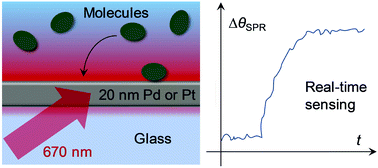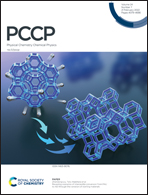Surface plasmon resonance sensing with thin films of palladium and platinum – quantitative and real-time analysis
Abstract
Surface plasmon resonance (SPR) is a highly useful technique in biology and is gradually becoming useful also for materials science. However, measurements to date have been performed almost exclusively on gold, which limits the possibility to probe chemical modifications of other metals. In this work we show that 20 nm Pd and Pt films work “fairly well” for quantitative SPR sensing of organic films despite the high light absorption. In the interval between total reflection and the SPR angle, high intensity changes occur when a film is formed on the surface. Fresnel models accurately describe the full angular spectra and our data analysis provides good resolution of surface coverage in air (a few ng cm−2). Overall, the Pd sensors behave quite similarly to 50 nm gold in terms of sensitivity and field extension, although the noise level in real-time measurements is ∼5 times higher. The Pt sensors exhibit a longer extension of the evanescent field and ∼10 times higher noise compared to gold. Yet, formation of organic layers a few nm in thickness can still be monitored in real-time. As a model system, we use thiolated poly(ethylene glycol) to make Pd and Pt protein repelling. Our findings show how SPR can be used for studying chemical modifications of two metals that are important in several contexts, for instance within heterogeneous catalysis. We emphasize the advantages of simple sample preparation and accurate quantitative analysis in the planar geometry by Fresnel models.



 Please wait while we load your content...
Please wait while we load your content...